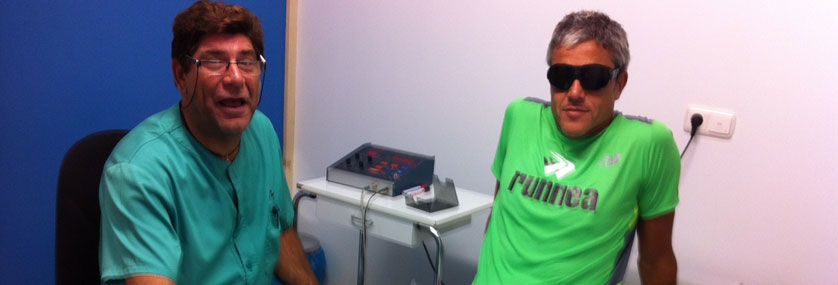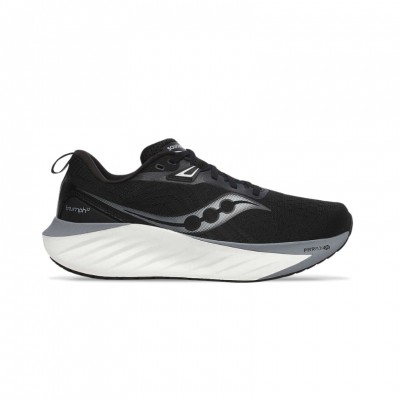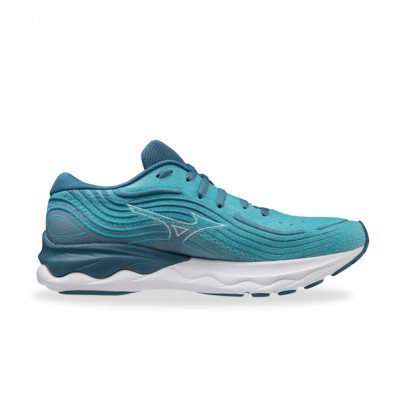Does your knee hurt, have inflammation, instability or just can not run ...? If you have been running for years and your knee has given you some other problem, surely you are one of those who have visited the orthopedic surgeon on more than one occasion and may even have made an MRI in which it is appreciated that your meniscus, ligaments and other structures suffer some kind of injury.
Are you considering arthroscopy....? Then you should try the high-power laser, a non-invasive method that sometimes allows you to avoid surgery.
The knee is the joint that receives the largest number of injuries in the running enthusiast, given the role it plays in the race on foot and in the support of body weight. Among the most common knee injuries suffered by runners is osteoarthritis or age-related joint degeneration. After the age of 40 it is normal to suffer some type of meniscal lesion and to have affected the cartilages of the knee that cause pain and inflammation. The wear and affectation of the meniscus is a degenerative process typical of age, in which the degree and type of sporting activity performed by the patient is a determining factor. There are other knee injuries such as ligament sprains, which directly or indirectly create instability in the joint affecting the dynamics and the state of the different structures that compose it.
Arthroscopy is the surgical procedure most commonly used to treat knee injuries and, despite being an invasive method, it is also used for diagnosis, since it allows visualization of the inside of the joints. But there are specialists in sports traumatology who believe that "more than 50% of knee arthroscopies are not necessary..." and that surgery can be avoided by using other types of treatments such as phototherapy or ultrasound and physical rehabilitation, which is key to recovery.
Undergoing an arthroscopy requires undergoing surgery under epidural anesthesia and with aseptic measures that sometimes do not exempt a high risk of complications.

About the meniscus
The menisci are fibrocartilage structures that are located between the femur and the tibia, and provide stability and congruence to the joint, allowing cushioning the loads and impacts that support the knee.
We have two menisci in each knee, the internal and the external, they have form of crescent in which three parts are differentiated, the anterior horn, the body or main part and the posterior horn. Most meniscal tears occur in the posterior horn of the internal meniscus because it is the area most susceptible to pinching between the femur and tibia in tibial flexion and rotation.

The symptoms, in addition to pain in the internal or external face of the knee depending on the injured meniscus that is relieved in rest, joint effusion and inflammation and, in occasions blockades produced by the piece of detached meniscus.
Treatment depends on the type and area of the meniscal tear, possible ligament and/or cartilage injuries, the age of the patient, the level of sports activity and the symptoms. In the meniscus two zones are differentiated according to the blood supply they receive, having a vascular zone more external of some millimeters of thickness that is irrigated by blood vessels and an avascular zone that does not have irrigation and therefore does not have capacity to heal.
In addition, small meniscal tears, especially longitudinal ones, can be healed with a correct recovery, especially in young patients. It is known as "meniscectomy" to the suture of the meniscus trying to preserve the structure of the meniscus intact which allows to return to the sport activity. Well, if your meniscus injury is a vascular area, good results can be obtained without undergoing surgery, that is, without the need for arthroscopy, thanks to the "intervention" with high power laser.
The word LASER is the acronym for Light Amplified by Stimulated Emission of Radiation being its main effects the biostimulation by the action of light photons. For this treatment we have gone to the Physiotherapy and Rehabilitation Center of the Antonio Periquet Gil Foundation, in the Belartza Industrial Park in Usurbil (San Sebastian), where they have been using the biostimulating properties of laser light for 20 years.

"Laser "intervention
The first thing to clarify is that it is not a surgical intervention as such, in fact it is called "intervention" because it intervenes on the joint but it is painless, anesthesia and no surgical material is used except the laser. To perform the laser intervention you only need a recent MRI of your knee to locate the exact location and extent of the injury.
Antonio Periquet Gil, before applying the laser in addition to carefully interpret the MRI (he is a specialist in diagnostic imaging), uses a curious scanner to locate the exact area of application. This scanner bases its practicality in allowing to locate in a simple, fast and economic way the points with greater thermoelectric activity, that is to say, the scanner locates in an exact way those points that suffer an inflammatory, destructive process or are supporting more stress.
Interestingly, the scanner, as if it were a real machine, will confirm the exact location of the damaged structure according to MRI and will also determine the degree of cellular hyperactivity.
The laser application is painless and the procedure lasts about 15 minutes, requiring eye protection with special glasses and control of the patient's blood pressure before and after. Immediate vasodilatation activates lymphatic drainage, which achieves the anti-inflammatory effect, but also lowers blood pressure, a factor that must be controlled and taken into account by the patient.
Antonio uses during the process different types of lasers depending on the depth, area and type of structure, varying the power required to achieve the effect of stimulating the mechanisms and natural processes of tissue regeneration.

The laser light photons penetrate deeply up to several centimeters depending on the frequency of the wave, making the energy available inside the cell. On the nerve cells the laser decreases sensitivity and blocks the transmission of pain to the brain, something that is found throughout the duration of the treatment coming to notice how the painful symptomatology ceases improving the functionality of the affected area.
After the intervention, an immobilizing and compressive bandage is applied, which must be worn for a few weeks to allow the increased metabolic activity to optimize nutrition and the elimination of waste, stimulate the development of fibroblasts, which are the cells that create collagen and collagen is the essential protein for repairing tissue lesions.
At one week the bandage is removed and rehabilitation begins for two weeks by performing joint mobility and muscle elasticity, strength and proprioception exercises first in the pool and then outside. After 2 weeks, pedaling is started and running is introduced cautiously and progressively.
In my opinion the result of laser therapy obtains greater results when combined with the correct rehabilitation by a physiotherapist, since on the one hand it reduces pain and reduces inflammation of the affected tissues, and on the other hand it facilitates the functional rehabilitation of the athlete.
The area of the meniscus exposed to the laser is repaired without the need for arthroscopy, and recovery is faster; the results with hundreds of patients lead to the conclusion that laser phototherapy is an effective therapeutic technique in the repair of damaged tissues and is especially recommended in the recovery of partial meniscal lesions in vascularized areas.

Some interesting facts
In the United States, the Food and Drug Administration (FDA) already authorized the use of Class IV or "High Power" lasers in 2003 due to their innumerable therapeutic results. This type of laser with a wavelength of 980 nm, allows to obtain anti-inflammatory and analgesic effects and the most important in certain sports pathologies is its biostimulatory effect, allowing the regeneration of damaged tissues. It can penetrate up to 8 cm. Something impossible with other lasers and its high power allows greatly accelerate tissue regeneration shortening recovery times and what is more important allowing in some cases to avoid surgery ....
These properties make it the most effective non-invasive treatment for the treatment of inflammation, pain and tissue regeneration in acute and chronic pathologies derived from sports practice.
According to several scientific studies*, its effects are obtained at the electrochemical level by promoting energy supply in the cell, thus accelerating its metabolism (biostimulation) and stimulating fibroblasts, which are responsible for tissue repair. The anti-inflammatory effect is achieved by favoring cellular oxygenation and stimulating local blood circulation, the reduction of pain is related to the depolarization of the sensitive fibers.
The review and analysis of various scientific studies corroborates a positive effect of laser phototherapy on tissue repair and pain control. In addition, the meta-analysis revealed the positive effects of various wavelengths of laser light on tissue repair by increasing collagen, the treatment effect being greater in relation to the laser power.
*Laser efficacy in tissue repair and pain control: a meta-analysis study. Photomedicine and Laser Surgery. Chukuka S. Enwemeka , Jason C. Parker , David S. Dowdy , Erin E. Harkness , Leif E. Harkness , and Lynda D. Woodruff . Photomedicine and laser surgery . August 2004.
This meta-analysis of the various scientific studies on the effects of laser therapy was conducted by Health Professions and Behavioral Sciences at the New York Institute of Technology, the Department of Physical Therapy and Rehabilitation Sciences at the University of Kansas Medical Center, and the Department of Physical Therapy at North Georgia College & State University.

More information at
- Antonio Periquet Gil Foundation. Rehabilitation and Physical Therapy Center.
- Polígono Belartza (Gurutzegui Kalea 12, 1º).
- Donostia (Gipuzkoa) and Mora de Ebro (Tarragona).
- Appointments 948 401992
- BPXport Kirol Zerbitzua.
Note
A Foundation is a non-profit organization, currently Antonio Periquet Vives develops in San Sebastian and Mora de Ebro the will of his father, the founder Dr. Antonio Periquet Gil, who worked for years in research and application of the use of lasers for therapeutic purposes. The Antonio Periquet Gil Foundation makes laser technology available to athletes and society in general for the recovery and rehabilitation of injuries.
This type of laser can also be found in private clinics such as the prestigious Teknon in Barcelona and the TAD Clinic in La Coruña.

Read more news about: Sports Injuries



















